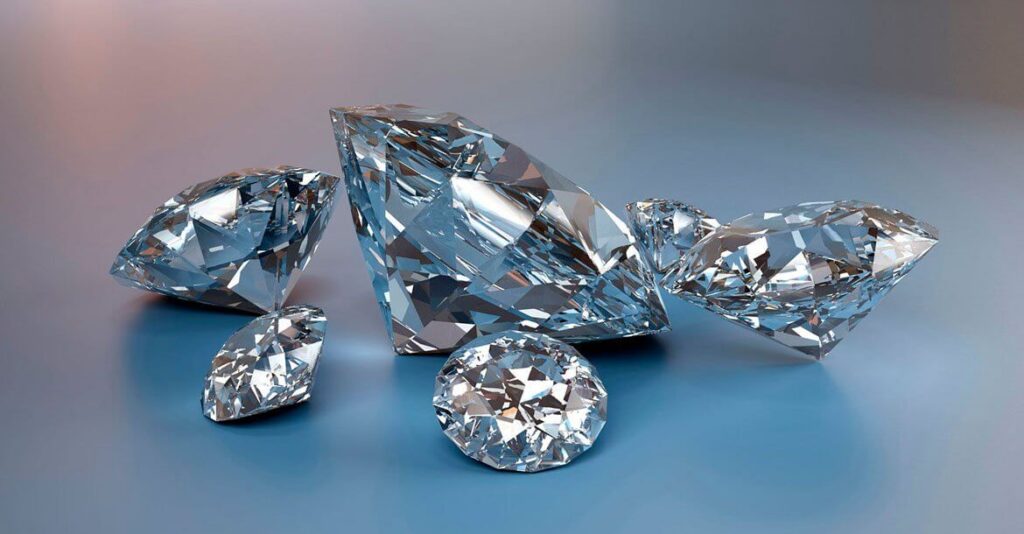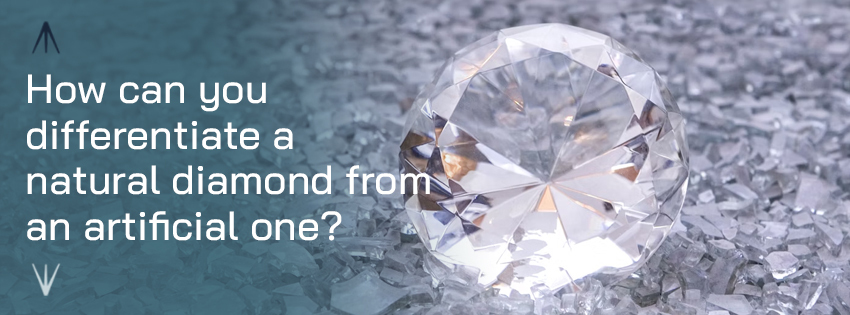The Fascination with Diamonds
Diamonds have always captivated humanity with their unparalleled beauty and exceptional hardness. Today, with the rise of synthetic diamonds, it is crucial to know how to differentiate between a diamond formed in the depths of the Earth and one created in a laboratory. This article will guide you through the key differences and identification methods.
History and evolution of the use of natural and synthetic diamonds
Since time immemorial, diamonds have been considered symbols of power, wealth and eternal love. Ancient civilizations such as the Romans and Greeks already attributed magical and protective properties to these gems, while in India they were used both in religious rituals and in noble jewelry.
The market for natural diamonds was consolidated in the 19th century with the expansion of mining in Africa and the famous marketing strategy of De Beers, which established the diamond as the ultimate symbol of marital commitment with the iconic phrase “A diamond is forever.”
However, the 21st century has witnessed a revolution in the industry with the appearance of synthetic diamonds. Although these were first created in the 1950s for industrial applications, their use in jewelry has grown significantly in recent years. Thanks to advances in synthetic technology, lab-grown diamonds now offer a visually indistinguishable alternative to natural diamonds, creating a shift in consumer perception and the jewelry industry.
What is a Natural Diamond?
Natural diamonds are gems that have been formed by geological processes beneath the Earth’s surface. This process involves exposure to high temperatures and extreme pressures over millions of years, transforming carbon into a unique crystalline structure. Natural diamonds are not only rare, but each one carries a unique geological history. If you want to delve deeper into how these fascinating diamonds are formed in nature, we invite you to read our detailed article on the subject.

What is a Synthetic Diamond?
In contrast to natural ones, synthetic or artificial diamonds are produced using advanced technologies that mimic natural conditions over a much shorter period. These gems are chemically identical to natural diamonds and offer an ethical and economically accessible alternative. The most common methods for creating synthetic diamonds include Chemical Vapor Deposition (CVD) and High Pressure High Temperature (HPHT).

Synthetic Diamond Production Methods
The manufacture of synthetic diamonds is a feat of modern engineering that reproduces the incredible natural process of diamond formation, but in a controlled environment. The two predominant methods used are High Pressure High Temperature (HPHT) and Chemical Vapor Deposition (CVD).
HPHT (High Pressure High Temperature)
This method is one of the oldest and most commonly used for the production of synthetic diamonds. It mimics the natural conditions under which diamonds are formed in the Earth’s mantle. In this process, a small fragment of natural diamond, known as a “seed,” is placed alongside pure carbon in a specialized press. The press can simulate the extreme pressures and temperatures of the Earth.
HPHT process steps:
- Seed and carbon preparation: A small fragment of natural diamond is placed in the center of the press and surrounded by pure carbon.
- Heat and pressure application: The press heats the material to approximately 1,400-1,600 degrees Celsius and applies a pressure of about 5-6 GPa (gigapascals).
- Diamond growth: Under these conditions, the carbon dissolves and begins to crystallize in the structure of the diamond seed, gradually forming a larger diamond.
CVD (Chemical Vapor Deposition)
A newer and increasingly popular technique due to its versatility and efficiency, CVD allows for more detailed control over diamond growth. This method does not require high pressures like HPHT, making it more economical and accessible.
CVD process steps:
- Gas chamber preparation: A mixture of gases, including a carbon-rich gas such as methane, is introduced into a vacuum chamber.
- Gas ionization: Energy, such as microwaves or lasers, is used to ionize the gas, breaking it down into carbon atoms.
- Carbon deposition: Carbon atoms are deposited on a pre-existing diamond seed placed in the chamber. The atoms accumulate layer by layer, gradually forming a crystalline diamond.
Advantages of CVD over HPHT:
- Impurity control: The CVD process allows for more precise control over impurities, which can result in higher quality diamonds with fewer defects.
- Flexibility in shape and size: CVD can produce diamonds of different shapes and sizes, which is ideal for specific applications, such as use in the electronics industry or in jewelry.
- Lower environmental impact: By requiring less energy and resources, the CVD method is more environmentally friendly compared to HPHT.
These advanced production methods are transforming the diamond industry, offering sustainable and ethical alternatives to traditionally mined diamonds, without compromising the quality or beauty of these precious gems.
Differences Between Natural and Artificial Diamonds: Characteristics, Identification, and Value
Although natural and synthetic diamonds may look identical at first glance, there are fundamental differences that set them apart, not only in their formation but also in their physical properties and their impact on the market.

Characteristics
Natural Diamonds: They are formed beneath the Earth’s surface through geological processes involving high pressure and temperature. These diamonds often contain unique inclusions and color variations that are testimonials of their natural origin. These characteristics not only make them unique but can also affect their brilliance and color in ways that are valued by collectors and jewelry experts.
Synthetic Diamonds: Produced in a laboratory, these diamonds are manufactured using processes such as high pressure and high temperature (HPHT) or chemical vapor deposition (CVD). Synthetic diamonds tend to have fewer inclusions and more consistent color uniformity due to the controlled conditions of their creation. This can result in a cleaner and more perfect appearance, which while desirable for some, may lack the small ‘imperfections’ that give character to natural diamonds.
Identification and Testing
Differentiating between a natural and a synthetic diamond without the proper tools is extremely difficult, as they share the same chemical structure and physical properties. The use of advanced equipment such as spectrometers and X-ray machines is crucial for identifying the true nature of the gem. These instruments can detect the slightest differences in crystal structure or trace chemicals that are often invisible to the human eye.
Impact on Value and Market
Value: Natural diamonds typically hold greater value in the market due to their rarity and the unique conditions required for their formation. The history, tradition, and romance associated with natural diamonds also play a significant role in their valuation.
Market: Meanwhile, synthetic diamonds are gaining popularity and acceptance due to their more accessible price and lower environmental impact. Their availability and lower cost make them appealing to a broader segment of buyers, and they are beginning to carve out their own niche in the jewelry market. However, the perception that they are ‘less authentic’ can affect their resale value and long-term demand.
Choosing between natural and artificial diamonds depends on the buyer’s personal priorities, including budget, ethical considerations, and preference for certain aesthetic features. Both types of diamonds offer significant advantages, and the final decision should be based on an informed understanding of these fundamental differences.
Synthetic Diamonds in Fine Jewelry: Are They Accepted in the Luxury Market?
For decades, fine jewelry has relied exclusively on natural diamonds for their rarity and exclusivity. However, in recent years, some luxury brands have begun to explore the use of synthetic diamonds, redefining market standards.
Brands such as Tiffany & Co., Cartier and Pandora have integrated lab-grown diamonds into some of their collections, promoting a more sustainable and accessible option. Even in the fashion industry, designers such as Gucci and Louis Vuitton have incorporated synthetic diamonds into exclusive pieces, arguing that they offer greater control over the quality and ethics of production.
Despite this, many luxury buyers still prefer natural diamonds for their history and perceived value. Auction houses such as Sotheby’s and Christie’s continue to bet on natural diamonds, especially those with unique provenances or uncommon colors, which can fetch million-dollar prices.
The key question is: will synthetic diamonds replace natural diamonds in the luxury market? Although they are unlikely to completely displace natural diamonds, their growing acceptance suggests that they will play an increasingly important role in fine jewellery, especially among younger consumers who are looking for ethical and sustainable alternatives.
Aesthetic Differences Between Natural and Artificial Diamonds
Although natural and artificial diamonds might appear similar, there are significant aesthetic differences that distinguish them, influenced by their origins and formation processes.
Inclusions and Coloration:
- Natural Diamonds: Typically contain inclusions or ‘imperfections’ which are small impurities or internal defects. These inclusions are often tiny minerals or internal fractures known as ‘feathers’. They may also display a wider range of natural colors, from colorless to slightly yellow or brown, depending on the presence of certain elements like nitrogen.
- Artificial Diamonds: Have fewer inclusions due to the controlled conditions of their growth. This can result in a cleaner and more uniform appearance. In terms of coloration, artificial diamonds can be engineered to achieve high levels of color or clarity more consistently, though some processes may introduce distinctive colors not found in nature.
Brilliance and Light Refraction:
- Natural Diamonds: The way light reflects and refracts through natural diamonds is complex due to their irregular crystal structure and the variations caused by inclusions. This can lead to a slightly different light spectrum, which is valued for its uniqueness.
- Artificial Diamonds: Controlled production allows for the optimization of structure to maximize brilliance and clarity. This might make artificial diamonds appear more ‘perfect’ and brilliant under certain lighting conditions, although sometimes they may lack the ‘fire’ or light dispersion characteristic of some natural diamonds.

Cut and Shape:
- Natural Diamonds: Although the cut of a diamond can be modified by a craftsman, the original shape of the rough diamond can influence the final design. Diamond cutters often have to work around natural imperfections to maximize the mass and value of the cut diamond.
- Artificial Diamonds: Can be designed and cut with greater flexibility and precision, as they are not limited by the irregularities of the rough diamond. This allows manufacturers and designers to create more uniform or customized shapes and sizes according to customer specifications without concerns about the limitations of the original material.
These aesthetic differences are essential for understanding why some consumers prefer natural diamonds for their unique character, while others opt for artificial diamonds for their consistency and visual perfection.
Technological Applications of Synthetic Diamonds Beyond Jewelry
Although synthetic diamonds are increasingly popular in jewelry, their true potential lies in technological and scientific applications.
✅ Advanced Electronics: Synthetic diamonds are used in the manufacture of high-performance semiconductors, as their ability to dissipate heat is superior to that of silicon. This makes them ideal for chips in high-speed devices and telecommunications systems.
✅ Aerospace and Military: Due to their extreme hardness and heat resistance, synthetic diamonds are used in the manufacture of coatings for spacecraft components and in advanced optics for night vision equipment.
✅ Medicine and Biotechnology: Synthetic diamonds also play a key role in modern medicine. They are being used in medical treatments such as implantable sensors, nanostructures for cancer therapies, and precision surgical tools.
✅ Industrial tools: From precision cutters to heavy-duty drill bits, synthetic diamonds have revolutionized the manufacturing industry by improving the durability and efficiency of various tools.
These applications demonstrate that laboratory-grown diamonds are not only an option for jewelry, but represent a revolution in multiple industrial sectors, consolidating themselves as a key material for the technology of the future.
Is it Possible to Differentiate a Natural Diamond from an Artificial One by Sight Alone?
Differentiating between a natural and an artificial diamond with just the naked eye is extremely challenging, even for experts. Although both types of diamonds share the same chemical composition and optical properties, there are subtle differences that require specialized tools to be identified effectively.
Visual Similarities: Both natural and synthetic diamonds can exhibit a high degree of brilliance and clarity, making them visually similar. Advances in synthetic diamond manufacturing techniques, such as HPHT (High Pressure High Temperature) and CVD (Chemical Vapor Deposition), have improved the quality of these diamonds, nearly perfectly mimicking the visual characteristics of natural diamonds.
Tools Needed for Distinction: Due to their similarities, differentiating these diamonds without the aid of advanced technology is nearly impossible. Instruments like gemological microscopes, spectrometers, and X-ray machines can detect differences in crystal structure or identify growth marks typical of synthetic diamonds.
Inclusions and Purity: Sometimes, the natural inclusions present in mined diamonds can provide clues about their origin. Natural diamonds often contain small impurities or internal defects formed during their geological creation, while synthetic diamonds tend to have fewer inclusions due to their controlled creation process.
Expertise and Training: Experienced jewelers and gemologists can sometimes suspect based on very subtle features and knowledge of cutting and polishing trends, but even they rely on specialized tools for definitive confirmations.
In conclusion, while natural and artificial diamonds may look identical at first glance, advanced technology and specialized expertise are necessary to confirm the true nature of the stone. For an average consumer without access to gemological tools, it is nearly impossible to make this distinction based solely on visual observation.
Frequently Asked Questions About Natural and Artificial Diamonds
How can you verify the authenticity of a diamond?
- Verifying whether a diamond is natural or artificial typically requires specialized equipment. Gemologists use tools such as loupe magnification, infrared spectroscopy, and fluorescence tests. These tools help identify the unique growth patterns and chemical traces distinctive to synthetic or natural diamonds.
Are there clear visual differences between natural and synthetic diamonds?
- To the unaided eye, both types of diamonds can look identical due to their similar refractive indices and dispersion qualities. However, under professional examination with microscopes, natural diamonds may show unique inclusions or slight color variations due to their natural formation process, which are less common in synthetic diamonds.
Why are natural diamonds usually more expensive than synthetic ones?
- Natural diamonds are more expensive due to their rarity and the extensive mining processes required to extract them. Additionally, natural diamonds often carry historical and emotional value, which can increase their market value compared to synthetic diamonds that are more abundant and easier to produce.
What is the environmental impact of natural versus synthetic diamonds?
- Natural diamond mining is often criticized for its environmental impact, including land degradation and water usage. Synthetic diamonds provide a less environmentally taxing alternative, as they require no mining and lower resources for production, making them a more sustainable choice in the long term.
Each of these questions addresses common concerns and highlights the distinctions between natural and synthetic diamonds, aiding consumers in making informed decisions based on not only the appearance and cost but also ethical and environmental considerations.




